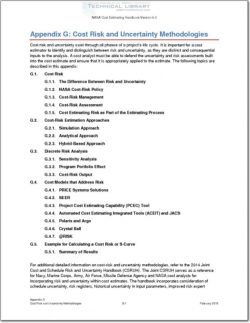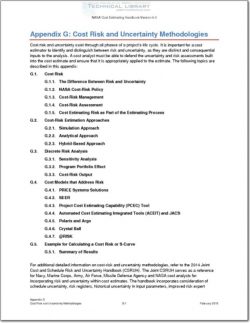NASA-CEH-APP-G

- Version
- 252 Downloads
- 1.97 MB File Size
- 1 File Count
- August 14, 2016 Create Date
- August 14, 2016 Last Updated
Appendix G; Cost Risk and Uncertainty Methodologies

Cost risk and uncertainty exist through all phases of a project’s life cycle. It is important for a cost
estimator to identify and distinguish between risk and uncertainty, as they are distinct and consequential
inputs to the analysis. A cost analyst must be able to defend the uncertainty and risk assessments built
into the cost estimate and ensure that it is appropriately applied to the estimate. The following topics are
described in this appendix:
G.1. Cost Risk
G.1.1. The Difference Between Risk and Uncertainty
G.1.2. NASA Cost-Risk Policy
G.1.3. Cost-Risk Management
G.1.4. Cost-Risk Assessment
G.1.5. Cost Estimating Risk as Part of the Estimating Process
62. Cost-Risk Estimation Approaches
G.2.1. Simulation Approach
G.2.2. Analytical Approach
G.2.3. Hybrid-Based Approach
6.3. Discrete Risk Analysis
G.3.1. Sensitivity Analysis
G.3.2. Program Portfolio Effect
G.3.3. Cost-Risk Output
6.4. Cost Models that Address Risk
G.4.1. PRICE Systems Solutions
G.4.2. SEER
6.4.3. Project Cost Estimating Capability (PCEC) Tool
G.4.4. Automated Cost Estimating Integrated Tools (ACEIT) and JACS
G.4.5. Polaris and Argo
6.4.6. Crystal Ball
G.4.7. @RISK
6.5. Example for Calculating a Cost Risk or S-Curve
6.5.1. Summary of Results
For additional detailed information on cost-risk and uncertainty methodologies, refer to the 2014 Joint
Cost and Schedule Risk and Uncertainty Handbook (CSRUH). The Joint CSRUH serves as a reference
for Navy, Marine Corps, Army, Air Force, Missile Defense Agency and NASA cost analysts for
incorporating risk and uncertainty within cost estimates. The handbook incorporates consideration of
schedule uncertainty, risk registers, historical uncertainty in input parameters, improved risk expert
elicitation, and other recent areas of innovation. Concepts are developed using one consistent example
throughout the Handbook. The Handbook web page also provides useful tools that assist with
incorporating the techniques described in the Handbook into cost estimates. The handbook is available
online at https://www.ncca.navy.mil/tools/csruh/index.cfm.
6.1. Cost Risk
NASA employs cost-risk assessments on its space missions in order to understand risks and help ensure
that resources and plans are adequate to deliver projects on time and within budget. Cost risk must be
carefully and quantitatively assessed in developing and presenting any cost estimate for several reasons.
First, when trade studies are conducted, a single cost estimate, such as an expected cost, may mislead
the trade team by not revealing the potential for overruns. Second, at Confirmation Reviews and Authority
to Proceed decision points, the cost estimate must include an appropriately chosen level of unallocated
future expense (UFE) to achieve a desired confidence level. The objective of a cost-risk analysis is to
produce a credible project cost cumulative distribution function (CDF, or “S-curve”) for the range of costs
of the project.
| File | Action |
|---|---|
| NASA-CEH-APP-G Appendix G; Cost Risk and Uncertainty Methodologies.pdf | Download |

Comment On This Post